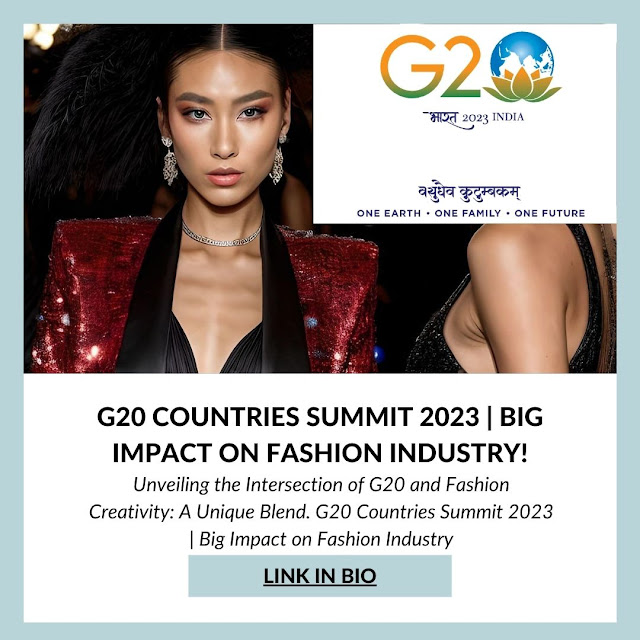Unveiling the Intersection of G20 and Fashion Creativity: A Unique Blend. G20 Countries Summit 2023 | Big Impact on Fashion Industry
1.) The Global Platform
The G20, initially established in 1999, brings together some of the world's largest economies, including the United States, China, Japan, Germany, and others. Its primary objective is to promote international financial stability and sustainable development through economic cooperation and dialogue. While these discussions may seem far removed from the glitz and glamour of the fashion industry, there is a deeper connection than meets the eye.
2.) Economic Powerhouses and Fashion Capitals
Several G20 member nations are also renowned as fashion capitals of the world. For instance, Paris, France, is synonymous with haute couture, while Milan, Italy, is a global fashion hub. The economic powerhouses within the G20 often play a pivotal role in shaping the fashion industry's trends and innovations.
3.) Economic Impact on Fashion
The economic policies and decisions made within the G20 member countries have a substantial impact on the global economy, including the fashion industry. Economic stability and consumer confidence directly influence fashion consumption patterns, affecting everything from clothing sales to luxury brand expansions.
4.) Trade Agreements and Fashion
Trade agreements negotiated within the G20 framework have far-reaching consequences for fashion. Tariffs, trade barriers, and intellectual property rights can impact the cost and availability of fabrics, materials, and fashion products across borders. These factors profoundly affect designers, manufacturers, and consumers alike.
5.) Sustainability and Fashion
In recent years, sustainability has become a crucial concern within the G20 discussions. As environmental awareness grows, sustainable fashion practices are increasingly in focus. G20 member nations are under pressure to enact policies that promote eco-friendly fashion, influencing the industry to adopt greener practices.
6.) Cultural Exchange
The G20 summits, where leaders from member countries converge, offer a unique platform for cultural exchange. These high-profile events often include cultural showcases and exhibitions. Fashion is a powerful form of cultural expression, and such events can introduce the world to the diverse fashion traditions of G20 nations.
7.) The Soft Power of Fashion Diplomacy
Fashion diplomacy, a subtle form of international relations, is becoming more prevalent. Leaders and diplomats use clothing to convey messages and promote their nations' cultural heritage. The G20 provides a stage for this soft power diplomacy, where fashion becomes a tool for building bridges between nations.
The G20's discussions on technology and innovation resonate with the fashion industry. From wearable tech to 3D printing, technological advancements are transforming the way fashion is created and consumed. Member countries' policies on innovation and intellectual property rights can either accelerate or hinder these developments.
9.)Globalization and Fashion Trends
Globalization, a recurring theme in G20 discussions, has a profound impact on fashion trends. As fashion brands expand into new markets, they blend elements of various cultures, creating unique and globally influenced styles. This cultural fusion often finds its roots in the international relationships fostered by the G20. I have shared a blog on different fashion esthetics that we see in our day-to-day lives. Design esthetic
The Conclusion
In conclusion, the seemingly distant worlds of the G20 and fashion creativity share a fascinating interplay. While the G20 primarily addresses economic and political matters, its decisions and policies ripple through the fashion industry, influencing everything from design aesthetics to sustainable practices. The G20 serves as a reflection of our interconnected world, where the threads of economics, politics, and fashion are woven together, creating a tapestry of global influence.
As we continue to witness the evolution of both the G20 and the fashion industry, it becomes increasingly clear that their relationship is not one of coincidence but rather a testament to the intricate web of connections that define our modern world. The influence of the G20 on fashion creativity is a captivating story of how diplomacy, economics, and style converge on a global stage, shaping the way we dress and express ourselves in an ever-changing world.

